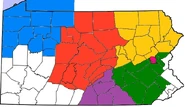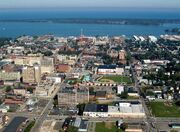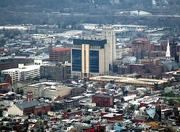Pennsylvania was one of the founding states of the United States of America. The former British colony joined the union in 1787 as the second colony to ratify the U.S. Constitution.
On Doomsday its two largest cities - Philadelphia and Pittsburgh, along with towns and suburbs in their vicinity - were destroyed by Soviet nuclear strikes. Also destroyed by direct hits were the state capital of Harrisburg, and the cities of Bethlehem, Erie, Scranton, and Wilkes-Barre. Allentown was severely damaged by the strike on Bethlehem and abandoned by survivors who fled west and southwest toward Reading. Waynesboro was also damaged due to the strikes on Camp David and the Raven Rock Mountain Complex. Willow Grove had to be abandoned due to the strike on Naval Air Station Joint Reserve Base Willow Grove. The towns and communities south of Wilkes-Barre and Scranton were evacuated by the few survivors to escape the fallout and radiation. Few survived to see the new year.
While the state saw the complete loss of three of its five largest cities and the death of millions, several nations and provisional governments have taken root in most of the state.
- The southeastern part of the state has come under the control of the Provisional Government of Pennsylvania in Reading, which is one of two provisional state governments that formed in the wake of Doomsday. After decided to split up the state government after Doomsday, several officials including the lieutenant governor, were sent to Reading. While initially limited to Berks County and Fort Indiantown Gap, it now controls most of the region. The capital and largest city is Reading.
- The south central part of the state is now independent as the Republic of Gettysburg. The nation has come under strong influence from Virginianin recent years and joined the East American Alliance at the end of 2022. Its capital is in the namesake borough of Gettysburg with its largest city being York.
- The southwestern part of the former state is now the State of Pennsylvania in the Republic of Virginia, with its capital in Waynesburg and the largest city being Washington. It encompasses much of the southern parts of the Pittsburgh metropolitan area. Virginia claims control of the entire southwestern part of the state, south of the former Interstate 80, and west of the Allegheny Mountains.
- The Northwestern and Allegheny regions of the state, extending into the former states of New York and Ohio are part of the Commonwealth of North Pennsylvania. The nation kept an ambiguous status, not declaring independence but not fully claiming to be a successor state. It has its capital in Warren and the largest city is Meadville.
- The north central region, centered around Happy Valley, is now the Provisional Government of Pennsylvania in State College, with the capital and largest city being State College. After Doomsday and the state government decided to split, the governor and most officials evacuated from Duncannon to State College.
- Northeast Pennsylvania is now an independent nation, the Commonwealth of Susquehanna. While the region was plagued with instability after Doomsday, it has managed to coalesce into a functioning nation since the 1990’s. The capital is in Bloomsburg, while the largest city is Hazleton. The nation has declared control over the entirety northeast Pennsylvania, however many communities in the northern reaches are functionally independent with little presence of the national government.
- A city state, Lehigh occupies a small region in southern Carbon County. It was occupied by gangs from Allentown in the 1990’s and later became a safe haven for them after the liberation of the city by Reading. In 2016, the community was liberated by a joint Reading-Susquehanna task force. The citizens were wary of both nations and were permitted supervised independence to avoid raiders from reoccupying the community. The capital is in Jim Thorpe, while the largest community is Lehighton.
Conversations with leaders in Reading and State College indicated two provisional state governments having been established in the 1980s in both locales, that evolved into two separate governments. Though no formal movement toward a unified government for all of Pennsylvania has been made in years, both locales do have a governor and legislature and a large degree of self-autonomy. There is also debate as to which city is the de facto state capital.
Virginia and Vermont explorers initially confirmed the existence of State College as the new state capital with leaders of the communities based in and around the forests. However, the explorers were told that the forest communities consider State College to have only the "barest" authority over their affairs and hold St. Mary's - halfway between Allegheny National Forest and the two state forests - as their capital. And, explorers were told Reading was the state capital.
Explorers reported all five regions as having a "steady, functioning, early 20th-century society" with people eager to hear what had happened to the rest of the country, and of the world.
Delmarvan and Virginian explorers found a stable government in the Reading area as well as a "lawless" situation in the Allentown region, which became the destination for gang members and criminals wanting autonomy especially from the Reading government.
For years there was no real single government over eastern Pennsylvania, as numerous gangs and warlords fought for control with surviving police and civic leaders and leaders of the remnants of Pennsylvania National Guard and U.S. Army units. Reading's government controlled the city and surrounding suburbs and towns, and gradually grew its control over the region; it was the largest, and most powerful, government in an area of that had become Balkanized into several dozen regions divided by town, farm, suburb, city block, even railroad track. The "law-abiding" groups led by police and National Guardsmen finally gained a measure of control over the region by 2002, consolidating power in Reading. The Reading government still has to deal with gang leaders who operate out of the remains of Allentown as well as warlords who make ongoing trade and contact with State College next to impossible.
Susquehanna has recently formed after stabilizing the region, and the local communities ended squabbling over supplies and agreed to collaborate in order to survive. They have recently defeated the remaining groups of raiders and gangs that Reading had driven out of Allentown, who took refuge in White Haven. Trade has increased as raiders have been cleared and and the interstates between them are secured.
In September of 2011, Reading forces attacked Allentown in an attempt to oust the raider gangs based there. After 34 days of intense urban warfare, the Reading National Guard successfully removed the raiders and absorbed Allentown by installing the pro-Reading Allentown Transitional Council.
In 2017, a combined force between Reading and Susquehanna attacked surviving raiders driven from Hazleton and Allentown who had escaped to Lehighton and enslaved the local population in southern Carbon County and the territory between the two countries in former Schuylkill County. After several weeks of both skirmishes and heavier combat, the remaining raiders were killed or arrested. This operation ended most of the raiders threat in the eastern part of the state which has resulted in a dramatic increase in trade with both Reading and State College.
In 2023, much of the northern and eastern reaches of the state have unified into a supranational organization, the Confederation of Pennsylvanian States, while Gettysburg has joined the East American Alliance and the southwestern part of the state is under the jurisdiction of Virginia.
Reunification[]
Serious discussion have been held between North Pennsylvania, State College, Reading, and Susquehanna on terms and agreements for formalized reunification. Even so, there are many issues to reach a unified Pennsylvania. Some of these problems are agreeing on a capital city, economic differences between the nations, and political issues. State College, Reading, and North Pennsylvania all dispute which of their capital cities (State College, Reading, Warren) should be the capital, while Susquehanna has proposed rebuilding Lewisburg as a new capital due to the relative central location between all the nations.
Economically, North Pennsylvania and State College have similar per capita incomes that are on par with rural Canada, due to the proximity to Lake Erie, the entire United Communities, and Canada. Reading has a very strong local economy as well as trade with Delmarva, Gettysburg, Virginia, and Kentucky. Susquehanna and Lehigh are significantly poorer than their neighbors, both nations suffer from relative isolation, limited industrial basis, and decades of conflict that damaged the economic output. This has resulted in both nations with economies focused around subsistence of the population but low GDP, low per capita GDP, and low trade output. However Reading and State College are collaborating with their governments to bring the nations up to the regional standard of living.
The last major stumbling block to reunification is the strength of political parties in each nation, as well as local, regional, and national powers in the proposed state and their allocations. State College and large portions of North Pennsylvania tend to be more conservative, while Reading and the more urban areas in North Pennsylvania tend to be more liberal. Susquehanna tends to be relatively even in political strength, though there are several libertarians in the government. Some national leaders do not want their party to lose strength in a unified Pennsylvania.
State College, being the recognized successor state to the Pennsylvania government has leaned towards a more centralized government with limited powers devolved to the other former national governments and they would allot powers to counties or municipalities as seen fit. The other nations dislike the idea of losing a majority of the power inherited by the post-Doomsday chaos, and in Susquehanna some officials are concerned that the democratic efforts made in the government will be ignored.
In 2019, leaders from North Pennsylvania, Reading, State College, and Susquehanna met in Williamsport, State College to discuss reunification. While talks were fruitful, no major forward momentum was made on reunification as Reading and State College disagreed on the future capital city and both North Pennsylvania and Susquehanna demanded to maintain high levels of autonomy in defense, domestic, and economic matters. While talks did not result in reunification or a timetable, it did clearly define what each country was looking for in reunification. Gettysburg had been invited however declined to attend as it gravitated towards the East American Alliance and Virginia.
Separately from the negotiations in State College, on August 1st, 2017; Lehigh, Reading, and Susquehanna signed a treaty which resulted in the formation of the Confederation of Pennsylvania States. The organization is a supranational defense and economic confederation, while all three member states retain high levels of autonomy.
Supporters[]
Many of the supporters for Pennsylvanian reunification tend to fall into three groups. The largest group are business leaders who believe a reunified state will provide increased economic opportunity to the state and improve international competition as it unifies a variety of economic activities under one umbrella. The second are older citizens born prior to Doomsday who remember the American hegemony and would like to see Pennsylvania rejoin the United States as a reconstituted state. The last group are conservatives who believe a reunified state will both promote reunification with the Torrington government and provide conservatives with a majority in government.
There is much support for reunification by the older populations of all the nations, recalling the glory days of America, and believing Pennsylvania could attain it with unification and work. Many believe that it will improve the economy through the fact that prospective partners will only need to deal with one entity rather than four, as well as increase political clout in the League of Nations and the United Communities.
Outside of the proposed territory several foreign governments including Canada, Delmarva, New York, and the former United States all support reunification as they believe a reunified state will serve as an effective counterbalance to Superior and Virginia. The Atlantic Defense Community has also indicated support for the nation as a pro-Canadian organization.
Opposition[]
Similar to proponents of reunification, there are three major camps who oppose a fully reunified Pennsylvania however two of the opposing groups are both political. The largest group are liberals and progressives who are concerned of overt conservative domination of the urban areas by conservative regions as the vast majority of the proposed state is agrarian and rural. The second largest group are libertarian conservatives who are concerned that a central authority will overrule regional and local decision-makers. Finally, the smallest group are the Amish who, while generally remaining separate from politics, believe that a reunified state will be detrimental to their ability to maintain autonomy from the government and may result in persecution.
The Amish in North Pennsylvania are heavily opposed to a reunified Pennsylvania, claiming Doomsday was God's work and they cannot oppose it. The short-lived regime in Warren caused tense relations with other survivor states, but with the new elections, they have improved. In Susquehanna the Amish have obtained a great deal of autonomy which have raised concerns about maintaining this post-reunification.
Some Democrats and progressives are opposed to reunification, with fears of being dominated by the Republican Party being prevalent. This is due to strong Republican majorities in virtually all the proposed member states.
Within other nations that either occupy territory or are successor states to Pennsylvania, Gettysburg opposes reunification and prefers to collaborate with Virginia and the East American Alliance. Virginia controls territory in the former southwestern portion of the state and claims a significant area beyond including all of the former Pittsburgh metropolitan area, and opposed a reunified state as it will have a stronger front to oppose Virginian territorial control. Some politicians in the Republic of New York from territories controlled in the former Northern Tier are worried that a unified state would seek to take these territories back, however proponents have assured the government this would not be the case.
Outside of the proposed territory, the members of the East American Alliance support Virginian and Gettysburg’s opposition for a reunified state. Both Saguenay and Superior oppose reunification as the proposed state would almost assuredly be aligned with Canada and the Atlantic Defense Community.
Survivor States[]
| Nation | Capital City | Largest City | Population | Area (km^2) | Independence | Status |
|---|---|---|---|---|---|---|
| Gettysburg | Gettysburg | York | 305,970 (2020 Census) | 1,352 | July 4, 1985 | Independent |
| Lehigh | Jim Thorpe | Leighton | 5,327 (2019 Census) | 202 | June 1, 2018 | Independent, under supervision of Reading and Susquehanna |
| North Pennsylvania | Franklin | Meadville | 701,293 (2020 Census) | 153,540 | N/A | Has not declared independence yet |
| Reading | Reading | Reading | 748,815 (2020 Census) | 4,454 | N/A | Declared Successor to Pennsylvania |
| State College | State College | State College | 911,651 (2020 Census) | 28,193 | July 4, 1985 | Declared Successor to Pennsylvania |
| Susquehanna | Bloomsburg | Hazleton | 254,596 (2020 Census) | 18,959 | September 12, 2005 | Independent |
Demographics[]
With the destruction of most major cities in the Commonwealth, the demographics changed dramatically. Due to a large concentration of minorities in urban areas that were hard hit, the surviving population was nearly uniformly of European descent. The gender percentages remain similar, with a composition of 49 percent male and 51 percent female.
Population[]
The former state of Pennsylvania has an estimated population of 1,808,842 in 2020 within one of the Pennsylvania survivor states plus an additional . The majority of the racial category is white European descent due to the destruction of Philadelphia, Pittsburgh, Erie, Wilkes-Barre/Scranton, and Harrisburg as well as the chaos in Allentown.
The estimated demographics of the state are:
- White: 97 percent
- White (European Descent): 94 percent
- White (Russian Descent): 1 percent
- White (Hispanic Descent): 1 percent
- White (Other): 1 percent
- Black: 1 percent
- Asian: 1 percent
- Other: 1 percent
Surviving urban areas, including Allentown, Reading, State College, Erie County, and Hazleton had significant surviving minority populations. College towns, such as Bloomsburg and Meadville had a visible minority population due to the institutions of higher learning drawing in these individuals. Overall, the most diverse nation is Reading, while the least diverse is Gettysburg.
Largest Cities[]
This is a list of the largest cities in the former state of Pennsylvania. The first list is the top five cities prior to Doomsday, while the second is the present list. None of the largest cities prior to Doomsday are presently on the list, with three of the five (Philadelphia, Pittsburgh, and Scranton) being abandoned due to damage or distance from survivor states, one in the process of reconstruction from a nuclear strike (Erie), and one untargeted city (Allentown) that lost a significant portion of the population due to infighting and raids.
The largest city presently, is Reading, which was the 6th largest city in Pennsylvania at Doomsday. None of the cities were targeted on Doomsday, though there were fears regarding Reading and State College. Other cities or communities with significant populations include: Bloomsburg, Coatsville, Edinboro, Gettysburg, Pottsville, and Williamsport.
Five Largest Cities (1980)[]
Five Largest Communities (2015)[]
| ||||||||||








